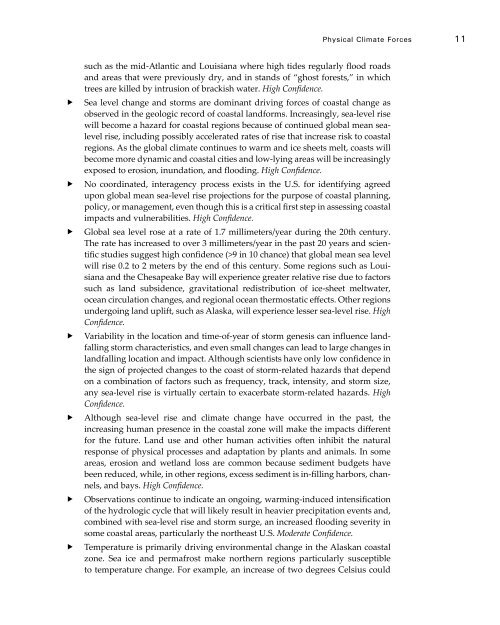Coastal Impacts, Adaptation, and Vulnerabilities - Climate ...
Coastal Impacts, Adaptation, and Vulnerabilities - Climate ...
Coastal Impacts, Adaptation, and Vulnerabilities - Climate ...
You also want an ePaper? Increase the reach of your titles
YUMPU automatically turns print PDFs into web optimized ePapers that Google loves.
Physical <strong>Climate</strong> Forces 11ffffffffffffffsuch as the mid-Atlantic <strong>and</strong> Louisiana where high tides regularly flood roads<strong>and</strong> areas that were previously dry, <strong>and</strong> in st<strong>and</strong>s of “ghost forests,” in whichtrees are killed by intrusion of brackish water. High Confidence.Sea level change <strong>and</strong> storms are dominant driving forces of coastal change asobserved in the geologic record of coastal l<strong>and</strong>forms. Increasingly, sea-level risewill become a hazard for coastal regions because of continued global mean sealevelrise, including possibly accelerated rates of rise that increase risk to coastalregions. As the global climate continues to warm <strong>and</strong> ice sheets melt, coasts willbecome more dynamic <strong>and</strong> coastal cities <strong>and</strong> low-lying areas will be increasinglyexposed to erosion, inundation, <strong>and</strong> flooding. High Confidence.No coordinated, interagency process exists in the U.S. for identifying agreedupon global mean sea-level rise projections for the purpose of coastal planning,policy, or management, even though this is a critical first step in assessing coastalimpacts <strong>and</strong> vulnerabilities. High Confidence.Global sea level rose at a rate of 1.7 millimeters/year during the 20th century.The rate has increased to over 3 millimeters/year in the past 20 years <strong>and</strong> scientificstudies suggest high confidence (>9 in 10 chance) that global mean sea levelwill rise 0.2 to 2 meters by the end of this century. Some regions such as Louisiana<strong>and</strong> the Chesapeake Bay will experience greater relative rise due to factorssuch as l<strong>and</strong> subsidence, gravitational redistribution of ice-sheet meltwater,ocean circulation changes, <strong>and</strong> regional ocean thermostatic effects. Other regionsundergoing l<strong>and</strong> uplift, such as Alaska, will experience lesser sea-level rise. HighConfidence.Variability in the location <strong>and</strong> time-of-year of storm genesis can influence l<strong>and</strong>fallingstorm characteristics, <strong>and</strong> even small changes can lead to large changes inl<strong>and</strong>falling location <strong>and</strong> impact. Although scientists have only low confidence inthe sign of projected changes to the coast of storm-related hazards that dependon a combination of factors such as frequency, track, intensity, <strong>and</strong> storm size,any sea-level rise is virtually certain to exacerbate storm-related hazards. HighConfidence.Although sea-level rise <strong>and</strong> climate change have occurred in the past, theincreasing human presence in the coastal zone will make the impacts differentfor the future. L<strong>and</strong> use <strong>and</strong> other human activities often inhibit the naturalresponse of physical processes <strong>and</strong> adaptation by plants <strong>and</strong> animals. In someareas, erosion <strong>and</strong> wetl<strong>and</strong> loss are common because sediment budgets havebeen reduced, while, in other regions, excess sediment is in-filling harbors, channels,<strong>and</strong> bays. High Confidence.Observations continue to indicate an ongoing, warming-induced intensificationof the hydrologic cycle that will likely result in heavier precipitation events <strong>and</strong>,combined with sea-level rise <strong>and</strong> storm surge, an increased flooding severity insome coastal areas, particularly the northeast U.S. Moderate Confidence.Temperature is primarily driving environmental change in the Alaskan coastalzone. Sea ice <strong>and</strong> permafrost make northern regions particularly susceptibleto temperature change. For example, an increase of two degrees Celsius could
















